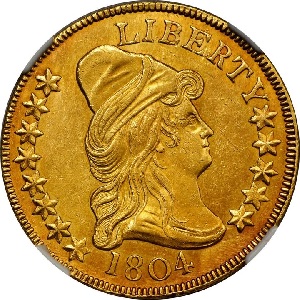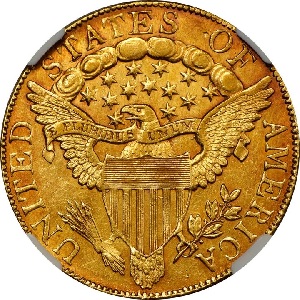1804 Capped Bust Large Eagle $10 Eagle, Cross 4
The $10 Capped Bust theme switched from a small eagle reverse to a large (often called Heraldic) eagle in 1797. This was in response to criticism of the scrawny appearance of the small eagle.(1)
In the minds of many, the smaller bird projected an image of weakness for the newly organized nation of the United States.
The Capped Bust Large Eagle $10 eagle was minted until 1804. It was discontinued because at that time, most United States gold coins never made it to circulation because bullion speculators were exporting them to Europe (where gold was valued higher) for meltdown and profit just as fast as the Mint could produce them.(2)
United States $10 gold eagles were not coined again until 1838, making the 1804 edition the last date of this denomination for many years.
Fascinating Fact: Although the 1804 was the last date for the Capped Bust eagle, die state analysis has revealed a small number of 1803 eagles (die variety BD-6) were actually the last of the Capped Bust eagles to be struck.
Numismatic guides indicate an 1804 mintage of 3,757. This came from a Mint report documenting a delivery of that number of pieces in late 1804, but this probably included some of the 1803 backdated BD-6 variety. Researcher John Dannreuther estimates a range of 2,500 to 3,757 coins struck for the circulation strike 1804 eagle, of which there are approximately 90 survivors.(3)
One die pair struck all of the 1804 eagles, easily distinguished by the cross 4 in the date. There also exists a proof version of the 1804 eagle, characterized by a plain 4. The proofs were restrikes, produced in 1834 for special presentation sets.(4) There are only three of the 1804 proofs known to exist, with examples selling for millions.(5)
As is true with so many early United States gold coins, the 1804 Capped Bust Eagle is immensely popular. Genuine examples of this classic rarity are highly coveted by advanced collectors, as evidenced by utterly spectacular price advancements over time. There is no reason to doubt this remains the long term outlook for this remarkable coin.
| Estimated survivors in all grades: 90 ?
The survivor estimate from PCGS represents an average of one or more experts' opinions as to how many examples survive of a particular coin in all grades. Survival estimates include coins that are raw, certified by PCGS, and certified by other grading services. Learn more at PCGS. |
| PCGS Rarity Scale: 8.1 ?
The 'PCGS CoinFacts Rarity Scale' assesses the relative rarity of all U.S. coins, based on estimated surviving examples. The scale runs from 1.0 to 10.0. The higher the number, the rarer the coin.
Learn more at PCGS. |
| Click HERE to check for availability on eBay** |
Preview of eBay selection (you may have better luck finding an 1804 $10 through the HERE link above):
 |
 |
| Trendline Avg = 16.44 | GOOD |
Historic Value Trend Charts:
| Last updated 9-6-24 | Return to Key Date Coin List | |
| Compare to Common Date Coin of Same Type | ||
|
|
||
| Download Charts to Your Computer | ||
Sources
1. Garofalo, Michael: America's First Gold Eagles: Part II. Greysheet, May 26, 2021.
2. Stack's Bowers Galleries. 1804 Capped Bust Right Eagle. BD-1, Crosslet 4. Nov 2022 Auction.
3. PCGS. 1804 $10 Crosslet 4 (Regular Strike).
4. Stack's Bowers Galleries. 1804 Capped Bust Right Eagle. BD-1, Crosslet 4. Nov 2022 Auction.
5. Heritage Auctions. 1804 $10 Plain 4, BD-2, PR65+. Jan 2021 Auction.
**Many very fine coin dealers sell on eBay. At any point in time, there may be over one million search results for United States coins. This includes quite a few of the recommendations on our Key Date Coin List.
If you’re thinking about purchasing a rare coin, eBay is certainly worth a look. For your convenience, the links from this site to eBay are coded to bring up only coins certified by PCGS and NGC.
As is always, always the case, never buy a valuable coin from a seller whose trustworthiness cannot be verified. Learn more about this at our chapter Best Places to Buy Coins, which also has a section on doing business on eBay.
In the interest of full disclosure, Rare Coins 101 receives a small commission anytime someone connects to eBay from this site and purchases something.
Coin images by Stack's Bowers Galleries.


